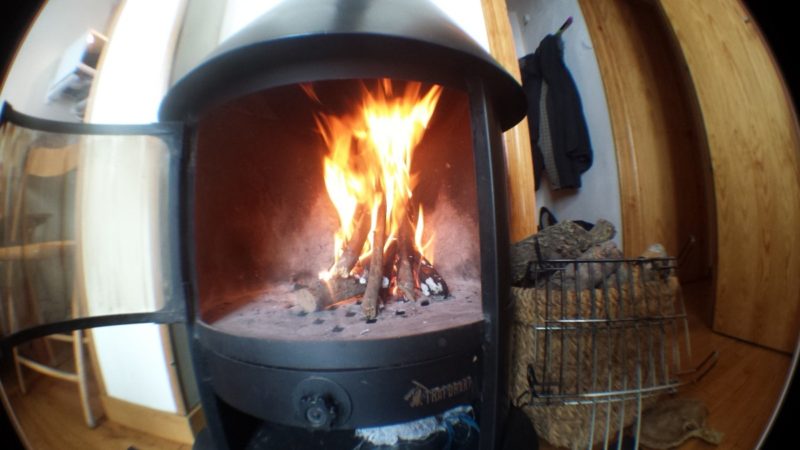Why does my wood stove smoke when I open the door? First, let’s look at a stove smoke’s most typical cause. Before we get into this, we will explore how a stove works and why smoke is so every day.
Your chimney has to take in the air, suck in the smoke, and pull it around and up the chimney to work. If your fireplace isn’t good enough, the suction is insufficient, and smoke returns to the room.
What we will do next is to explain why your path drives air down and how to correct it. There are several explanations and some people could discover a mixture of them. People with double-walled chimney systems are likewise in greater danger.
6 Common Reasons Why Does Wood Stove Smoke When I Open The Door
In this section, you will get to know the most common reasons that lead to smoke. I have encountered most of these problems in the past, so I decided to include some solutions. So, why does my wood stove smoke when I open the door?
#1. Baffle position
The first thing we propose is dual control over the correct setting of your trigger. The plate reflects the heat in the fireplace to make sure the fire burns efficiently. When you carefully verify that your fog is at the right place, you can permanently exclude a faulty fireplace. Now, specific stuff can make a smokey stove worse.
#2. Restrictive baffle
Some contemporary stoves feature tight confusion designs that operate well under test settings but are poorly connected to an inoperative chimney to enhance efficiency. You probably have a furnace of restricted bubbling design if you peek into your stove and can’t see how the fumes escape.
#3. Large door
If your oven has a substantial single door, it might easily stick the furnace smoke into the room. Therefore, you must open the door first and wait until the pressure is equal between the stove and the room before you gently open the door. The pressure gap and the fact that more smoke tries to exit the furnace on more significant single-door stoves always mean that smoking stoves would be more of a problem.
#4. Adverse pressure
Cold air is driven up the chimney when it’s chilly and foggy outside. Consequently, the fundamental physics concept is that cold air sinks and warm air rises. As a result, the smoke is physically pushed by the cold air downstream. Since they are frequently exposed to complex elements, double-wall chimneys are more popular.
In a property, traditional brick chimneys are warm and splendid, and exquisite. It is also a bit more frequent with gable flames that may get very cool towards the end of an estate. Get your fire ready for a big dry sparkle and some fire lights. Place some plain paper sheets on the burning stack and simultaneously ignite the firelights and the newspaper sheets.
A lot of air will rush into the stove if you leave the door open, and the flames on the top of the paper rapidly heat up the chimney, reversing the negative pressure.
Furthermore, you may use a lighter piece of paper to generate a similar effect by holding it close to the baffle entrance. If it doesn’t work, you might need a blow torch to adopt more extreme steps. Having a blow torch until the blast tip opens might also contribute to the instantaneous heat explosion. Now, if the flume is heated enough, it makes a ticking noise, but the flue is different for all. It is preferable to take things and make a tiny mistake slowly. We encourage that everyone stays careful when using this approach.
#5. Chimney height
Since there is not enough smoke to dress it up and down, it is a frequent source of smoke that comes back to the room with a short chimney (4 to 6 meters). You can contact your fireplace installer if you have a shallow chimney to make the fireplace legal or install a mechanical ventilation system. To know more, read on what you can do to wood smoke.
The pipe is supplied with a large chimney; however, it is too huge for the pipe. If the smoke cools and descends to the top of the chimney, it may be a problem. Again, flues or gable-end chimneys with the double wall are more prevalent.
You might consider separating the flue with vermiculite if you have a classic stone chimney to keep it warm and beautiful. Not only that, but you can also discuss the suitability of a different cowl or mechanical system with your installer. Most companies suggest a 4.5-meter fireplace with a Pascal 10 reading. Unfortunately, the combination of chimney height and negative pressure in most situations creates a significant difficulty.
#6. Blocked chimney
If your stove operates smoothly throughout the season and the mess is not disturbed, there could be a clamped chimney. Unfortunately, it is pretty dangerous since it can let fatal carbon monoxide into the room. To give you more ideas, know eight tips to stop smoke coming out of my woodstove door.
It’s A Wrap!
You should not only ask yourself: why does my wood stove smoke when I open the door. Likewise, you should do something about this problem. If you don’t know what to seek some professional help. For more articles about stoves, know what is a Franklin stove and how to line a wood stove with fire brick. That’s all for today! Thank you for reading.

